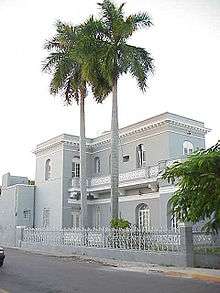Roystonea dunlapiana
Roystonea dunlapiana, commonly known as yagua or cabiche is a species of palm which is native to Nicaragua, Honduras, and southern Mexico (Chiapas, Campeche, Quintana Roo, Tabasco, Veracruz).[2] It is the only species in the genus Roystonea which is absent from the insular Caribbean.
| Roystonea dunlapiana | |
|---|---|
 | |
| Scientific classification | |
| Kingdom: | Plantae |
| Clade: | Tracheophytes |
| Clade: | Angiosperms |
| Clade: | Monocots |
| Clade: | Commelinids |
| Order: | Arecales |
| Family: | Arecaceae |
| Genus: | Roystonea |
| Species: | R. dunlapiana |
| Binomial name | |
| Roystonea dunlapiana | |
Description
Roystonea dunlapiana is a large palm which reaches heights of 20 metres (66 ft). Stems are grey-white and about 38 centimetres (15 in) in diameter. The upper portion of the stem is encircled by leaf sheaths, forming a green portion known as the crownshaft which is about 2 m (6.6 ft) long. Individuals have about 15 leaves with 4-metre (13 ft) rachises; the leaves hang well horizontal. The 1 m (3.3 ft) inflorescences bear white male flowers with purplish anthers; the female flowers are undescribed. Fruit are 12–14.7 millimetres (0.47–0.58 in) long and 7.1–9.5 mm (0.28–0.37 in) wide, and are purplish black when ripe.[3]
Taxonomy
Roystonea is placed in the subfamily Arecoideae and the tribe Roystoneeae.[4] The placement Roystonea within the Arecoideae is uncertain; a phylogeny based on plastid DNA failed to resolve the position of the genus within the Arecoideae.[5] As of 2008, there appear to be no molecular phylogenetic studies of Roystonea[4] and the relationship between R. dunlapiana and the rest of the genus is uncertain.
The species was first described by American botanist Paul H. Allen in 1952. Allen's description of R. dunlapiana, together with his description of R. regia var. hondurensis (now synonymised with typical R. regia) was the first record of Roystonea species native to Central America.[3]
Distribution
Roystonea dunlapiana is native to southern Mexico, Honduras and Nicaragua. In his monograph of the genus, Scott Zona reported that it is "likely to occur in Belize". It grows in estuaries and coastal swamps. It is the only species in the genus Roystonea which is absent from the insular Caribbean.[3]
References
| Wikimedia Commons has media related to Roystonea dunlapiana. |
- World Conservation Monitoring Centre. 1998. Roystonea dunlapiana. The IUCN Red List of Threatened Species 1998. Downloaded on 8 September 2015.
- Tropicos, distribution, Roystonea dunlapiana
- Zona, Scott (December 1996). "Roystonea (Arecaceae: Arecoideae)". Flora Neotropica. 71: 1–35.
- Roncal, Julissa; Scott Zona; Carl E. Lewis (2008). "Molecular Phylogenetic Studies of Caribbean Palms (Arecaceae) and Their Relationships to Biogeography and Conservation". The Botanical Review. 74 (1): 78–102. doi:10.1007/s12229-008-9005-9.
- Asmussen, Conny B.; John Dransfield; Vinnie Deickmann; Anders S. Barfod; Jean-Christophe Pintaud; William J. Baker (2006). "A new subfamily classification of the palm family (Arecaceae): evidence from plastid DNA phylogeny". Botanical Journal of the Linnean Society. 151 (1): 15–38. doi:10.1111/j.1095-8339.2006.00521.x.
